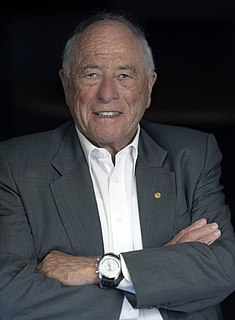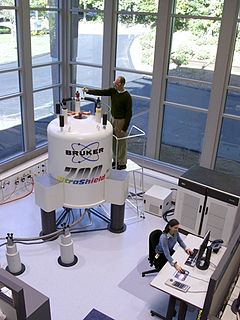External links
- National High Magnetic Field Laboratory faculty profile
- FSU Faculty profile on Timothy Cross' research
Timothy A. Cross is an American academic chemist who specializes in nuclear magnetic resonance (NMR) spectroscopy, membrane and computational biophysics, and biomathematics. He is a professor of chemistry at Florida State University and the Director of the NMR Program at the National High Magnetic Field Laboratory. His research focuses on the sets of proteins that are important for the pharmaceutical industry in the treatment of diseases such as the flu (Influenza A) and tuberculosis.

Kurt Wüthrich is a Swiss chemist/biophysicist and Nobel Chemistry laureate, known for developing nuclear magnetic resonance (NMR) methods for studying biological macromolecules.

Paul Christian Lauterbur was an American chemist who shared the Nobel Prize in Physiology or Medicine in 2003 with Peter Mansfield for his work which made the development of magnetic resonance imaging (MRI) possible.
The tesla is the unit of the magnetic B-field strength in the International System of Units (SI).

The National High Magnetic Field Laboratory (MagLab) is a facility at Florida State University, the University of Florida, and Los Alamos National Laboratory in New Mexico, that performs magnetic field research in physics, biology, bioengineering, chemistry, geochemistry, biochemistry. It is the only such facility in the US, and is among twelve high magnetic facilities worldwide. The lab is supported by the National Science Foundation and the state of Florida, and works in collaboration with private industry.
Ramanuja Vijayaraghavan is an Indian physicist, specializing in condensed matter physics.

Alexander Pines is an American chemist. He is the Glenn T. Seaborg Professor Emeritus, University of California, Berkeley, Chancellor's Professor Emeritus and Professor of the Graduate School, University of California, Berkeley, and a member of the California Institute for Quantitative Biosciences (QB3) and the Department of Bioengineering. He was born in 1945, grew up in Bulawayo in Southern Rhodesia and studied undergraduate mathematics and chemistry in Israel at Hebrew University of Jerusalem. Coming to the United States in 1968, Pines obtained his Ph.D. in chemical physics at M.I.T. in 1972 and joined the UC Berkeley faculty later that year.

Nuclear magnetic resonance quantum computing (NMRQC) is one of the several proposed approaches for constructing a quantum computer, that uses the spin states of nuclei within molecules as qubits. The quantum states are probed through the nuclear magnetic resonances, allowing the system to be implemented as a variation of nuclear magnetic resonance spectroscopy. NMR differs from other implementations of quantum computers in that it uses an ensemble of systems, in this case molecules, rather than a single pure state.
Dr. Naresh Dalal is an academic physical chemist who specializes in materials science. He is the Dirac Professor of Chemistry and Biochemistry at Florida State University, where he is affiliated with the National High Magnetic Field Laboratory. Dalal has synthesized a substance known as Fe8, one of the strongest magnets known, which has allowed new kinds of medical imaging to be possible.
Nuclear magnetic resonance (NMR) in the geomagnetic field is conventionally referred to as Earth's field NMR (EFNMR). EFNMR is a special case of low field NMR.
Herbert Sander Gutowsky was an American chemist who was a Professor of Chemistry at the University of Illinois Urbana-Champaign. Gutowsky was the first to apply nuclear magnetic resonance (NMR) methods to the field of chemistry. He used nuclear magnetic resonance spectroscopy to determine the structure of molecules. His pioneering work developed experimental control of NMR as a scientific instrument, connected experimental observations with theoretical models, and made NMR one of the most effective analytical tools for analysis of molecular structure and dynamics in liquids, solids, and gases, used in chemical and medical research, His work was relevant to the solving of problems in chemistry, biochemistry, and materials science, and has influenced many of the subfields of more recent NMR spectroscopy.
Rafael Brüschweiler is a scientist who studies nuclear magnetic resonance (NMR). He is credited for the development of Covariance NMR, which shortens the NMR measurement time for multidimensional spectra of both solution and solid-state NMR. It also allows for easier analysis and interpretation. For this achievement he was awarded the Laukien Prize in NMR Spectroscopy at the 47th Experimental Nuclear Magnetic Resonance Conference (ENC). He is also a leading scientist in NMR-based metabolomics and protein NMR.

Nuclear magnetic resonance (NMR) is a physical phenomenon in which nuclei in a strong constant magnetic field are perturbed by a weak oscillating magnetic field and respond by producing an electromagnetic signal with a frequency characteristic of the magnetic field at the nucleus. This process occurs near resonance, when the oscillation frequency matches the intrinsic frequency of the nuclei, which depends on the strength of the static magnetic field, the chemical environment, and the magnetic properties of the isotope involved; in practical applications with static magnetic fields up to ca. 20 tesla, the frequency is similar to VHF and UHF television broadcasts (60–1000 MHz). NMR results from specific magnetic properties of certain atomic nuclei. Nuclear magnetic resonance spectroscopy is widely used to determine the structure of organic molecules in solution and study molecular physics and crystals as well as non-crystalline materials. NMR is also routinely used in advanced medical imaging techniques, such as in magnetic resonance imaging (MRI).

Professor Ramakrishna Vijayacharya Hosur is an Indian biophysical scientist, known for his expertise in the areas of nuclear magnetic resonance and molecular biophysics. The Government of India honoured him, in 2014, by awarding him the Padma Shri, the fourth highest civilian award, for his contributions to the fields of science and technology.
Cynthia Larive is an American scientist and academic administrator serving as the chancellor of University of California, Santa Cruz. Larive's research focuses on nuclear magnetic resonance spectroscopy (NMR) and mass spectrometry. She was previously a professor of chemistry and provost and executive vice chancellor at the University of California, Riverside. She is a fellow of AAAS, IUPAC and ACS, associate editor for the ACS journal Analytical Chemistry and editor of the Analytical Sciences Digital Library.
Benjamin Lax was a solid-state and plasma physicist.
Narayanan Chandrakumar is an Indian chemical physicist and a professor of chemistry at the Indian Institute of Technology, Madras. He is the founder of the first Nuclear magnetic resonance (NMR) laboratory in India and is known for developing a new technique for NMR imaging and diffusion measurements. He is an elected fellow of the Indian National Science Academy and the Indian Academy of Sciences The Council of Scientific and Industrial Research, the apex agency of the Government of India for scientific research, awarded him the Shanti Swarup Bhatnagar Prize for Science and Technology, one of the highest Indian science awards, in 1996, for his contributions to chemical sciences.

Lucio Frydman is an Israeli chemist whose research focuses on magnetic resonance imaging (MRI), nuclear magnetic resonance (NMR) and solid-state NMR. He was awarded the 2000 Günther Laukien Prize, the 2013 Russell Varian Prize and the 2021 Ernst Prize. He is Professor and Head of the Department of Chemical and Biological Physics at the Weizmann Institute of Science in Israel and Chief Scientist in Chemistry and Biology at the US National High Magnetic Field Laboratory in Tallahassee, Florida. He is a fellow of the International Society of Magnetic Resonance and of the International Society of Magnetic Resonance in Medicine. He was the Editor-in-Chief of the Journal of Magnetic Resonance (2011-2021).

Timothy George Haskell is a New Zealand scientist.

María Guðjónsdóttir is a professor of food science at the University of Iceland.

{{Infobox scientist | name = Anil Kumar | image = Anil Kumar (physicist).gif | alt = | caption = | birth_date = 25 June 1941 | birth_place = | death_date = | death_place = | nationality = Indian | spouse = Padma Kumar | children = Pankaja and Ankur | known_for = Studies on [[Nuclear magnetic resonance spectroscopy],[Quantum information processing]] }}